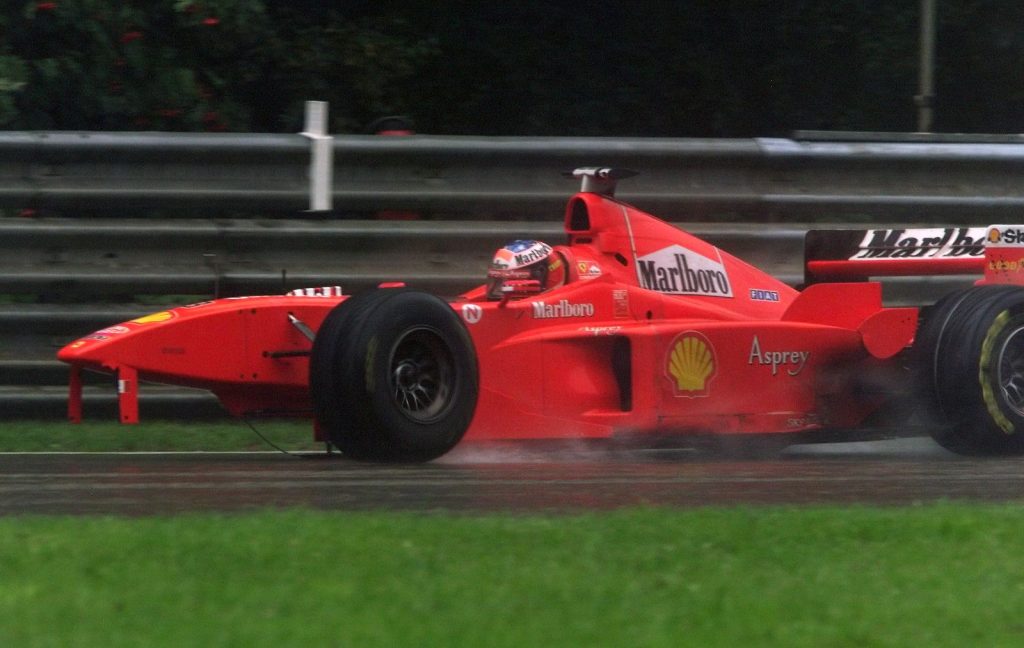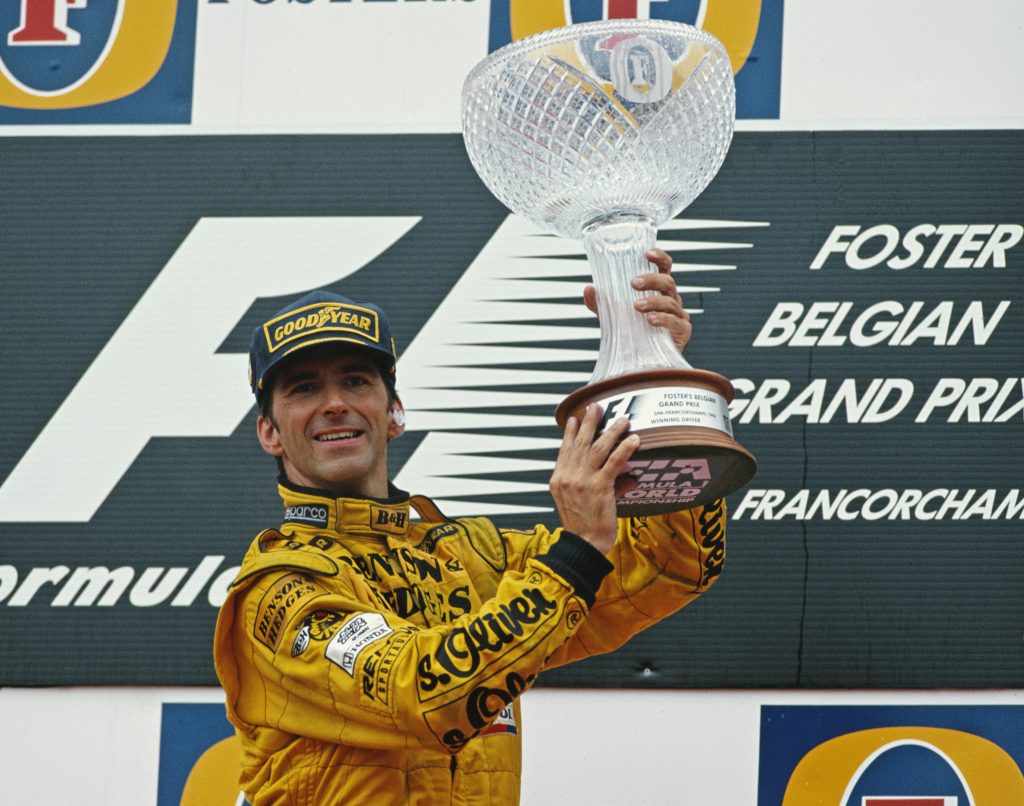Rain is one of the factors that can throw up an unexpected result at any motor race. And in Belgium’s Ardennes, where the country’s Formula One race is held, the weather is famously unpredictable. We put our raincoat on and look back at the 1998 Belgian Grand Prix.
18 seconds. That was all it took before utter mayhem was unleashed following the first start of the 1998 race at Spa-Francorchamps. Multi-car crashes don’t come more spectacular or expensive than this.
The Belgian Grand Prix begins with a short sprint to the right-hand La Source hairpin bend. In heavy rain David Coulthard, from second on the starting grid, ran wide exiting the corner. His McLaren then clipped a kerb that span it back into the middle of the chasing pack.
Pandemonium ensued. Cars pinged off each other like dodgems. Spray combining with steam from shattered radiators made the madness even more confusing for cars towards the back of the field who slammed into the chaos as if drawn by an invisible magnet.

By the time cars had stopped hitting each other, errant wheels had stopped bouncing and the steam and spray had dissipated, 13 cars lay among the wreckage. It remains the most expensive crash in Formula One history with an estimate £11 million worth of damage.
Damon Hill recalled: “There was a lot of spray and I saw that Coulthard had hit the wall on the right-hand side and he’s coming back across the track. I was coming at him and I could see that he was coming across together with a bouncing wheel so I had to just go for it and got through without hitting a thing.”
That was crucial because after the race was stopped, the track cleared, drivers who could had got into spare cars (allowed in those days) and the race restarted, it was Mika Hakkinen’s turn to spin his McLaren out. That meant Hill in his Jordan-Honda found himself in an early lead from third on the grid.
It didn’t last long. On the soaking track, Michael Schumacher passed him on lap seven. The Ferrari driver, mastering the soaking track brilliantly, now set about building a lead and improving his chances of powering past Hakkinen in the driver’s championship standings.
On lap 25 as he started to close down Coulthard’s McLaren to lap it, Schmacher was a healthy 37 seconds in front of Hill. Nonetheless, Ferrari team chief Jean Todt wasn’t leaving anything to chance. He jumped down from his perch on the pitwall and went for a word with McLaren boss Ron Dennis.
After 12 of the season’s 16 races, the 1998 championship was between two teams, McLaren and Ferrari, and their two quickest drivers, Schumacher and Mika Hakkinen. The previous season, the German had been disqualified from the year’s overall classification for trying to take rival Jacques Villeneuve’s Williams out of the European Grand Prix and championship decider.
For ’98, Schumacher was seeking redemption and still trying to win his first championship with Ferrari. But it was Hakkinen who had topped the championship for the whole season, even if going into the Belgian weekend, the Finn’s advantage over his German rival was a slender seven points.
Ferrari knew that with Hakkinen out of the Belgian race and 10 points on offer for a win, this was a priceless chance to take the lead in the title race for the first time that year.
In his sodden overalls inside the McLaren, Coulthard heard Ron Dennis say: “Make way for Schumacher as quickly as you can.” The Scot looked in his mirror and saw just a wall of spray. “Tell me exactly where he is,” he replied. Schumacher continued to close.
Coulthard ran wide at La Source but elected not to let the German past. Through the daunting Eau Rouge and the following straight the Ferrari remained in the McLaren’s wake.
Spa-Francorchamps is revered by drivers for being one of the most challenging tracks on the calendar. Pouhon is one of its trickiest corners, taken at around 190mph in the dry. Rushing towards it, David elected to ease off the accelerator.
Behind him, part blinded by the spray, Schumacher was closing, closing, then confused: the McLaren was slowing but not moving off the racing line. Michael jinked left to pass the silver car but it was too late. His front right wheel hit his rival’s left rear and was ripped off, taking the McLaren’s rear wing with it.

Both cars nonetheless returned to the pits where Schumacher stormed down to the McLaren garage and accused Coulthard of trying to kill him. Calm and collected he was not.
Meanwhile in the lead of the race, Damon Hill felt relaxed. It was nearly two years since the 1996 world champion had won his 21st and final race for Williams. New at Jordan for ’98, his season so far had been a struggle.
Unable to get the Honda-powered car to his liking, the Briton hadn’t scored a point until two races before Belgium. Now he was leading and Jordan – a team yet to win a grand prix – had its other driver, Ralf Schumacher, in second place.
The younger Schumacher brother was all that was threatening Hill’s win at that point. Ralf was leaving Jordan at the end of the year so the pit wall radioed him to suggest he held position. Silence followed, an uncomfortable few seconds before Schumacher came over the radio to say he would comply.
All Damon had to do was run down the laps. Apart from a grassy excursion on lap 27 at the Bus Stop chicane, when the slippery track surface caught him out, he had driven beautifully.

For Jordan it was the first grand prix win in 127 attempts over eight seasons. The extrovert Eddie Jordan was naturally delighted, not only that his cars had finished first and second but also that his was the only team to get two cars to the finish in such atrocious conditions.
It turned out to be Hill’s 22nd and last win in Formula One. Damon is of course famous for winning all his other grands prix for Williams, at the time, the dominant car in F1. The Belgian win was proof that on his day, the Briton was a very fine racing driver indeed – and he didn’t need the best car to prove it.
Read more
Masterclass: When Nigel Mansell destroyed Nelson Piquet at the 1987 British Grand Prix
The art of selling the first Ferrari F1 car driven by Michael Schumacher
The epic challenge of building a Tyrrell P34 six-wheel F1 continuation car









